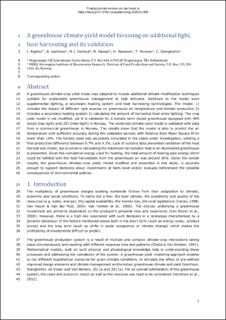| dc.contributor.author | Righini, Isabella | |
| dc.contributor.author | Vanthoor, Bram | |
| dc.contributor.author | Verheul, Michel | |
| dc.contributor.author | Naseer, Muhammad | |
| dc.contributor.author | Maessen, Hendricus | |
| dc.contributor.author | Persson, Tomas | |
| dc.contributor.author | Stanghellini, Cecilia | |
| dc.date.accessioned | 2020-12-22T09:16:08Z | |
| dc.date.available | 2020-12-22T09:16:08Z | |
| dc.date.created | 2020-04-20T22:01:34Z | |
| dc.date.issued | 2020-03-31 | |
| dc.identifier.citation | Biosystems Engineering. 2020, 194 1-15. | en_US |
| dc.identifier.issn | 1537-5110 | |
| dc.identifier.uri | https://hdl.handle.net/11250/2720706 | |
| dc.description.abstract | A greenhouse climate-crop yield model was adapted to include additional climate modification techniques suitable for enabling sustainable greenhouse management at high latitudes. Additions to the model were supplementary lighting, secondary heating and heat harvesting technologies. The model: 1) included the impact of different light sources on greenhouse air temperature and tomato production 2) included a secondary heating system 3) calculated the amount of harvested heat whilst lighting was used. The crop yield model was not modified but it was validated for growing tomato in a semi-closed greenhouse equipped with HPS lamps (top-lights) and LED (inter-lights) in Norway. The combined climate-yield model was validated with data from a commercial greenhouse in Norway. The results showed that the model was able to predict the air temperature with sufficient accuracy during the validation periods with Relative Root Mean Square Error <10%. Tomato yield was accurately simulated in the cases under investigation, yielding a final production difference between 0.7% and 4.3%. Lack of suitable data prevented validation of the heat harvest sub-model, but a scenario is presented calculating the maximum harvestable heat in an illuminated greenhouse. Given the cumulative energy used for heating, the total amount of heating pipe energy which could be fulfilled with the heat harvestable from the greenhouse air was around 50%. Given the overall results, the greenhouse climate(-crop yield) model modified and presented in this study is considered accurate enough to support decisions about investments at farm level and/or evaluate beforehand the possible consequences of environmental policies. | en_US |
| dc.language.iso | eng | en_US |
| dc.publisher | Elsevier Ltd | en_US |
| dc.relation.uri | https://www.sciencedirect.com/science/article/pii/S1537511020300726 | |
| dc.title | A greenhouse climate-yield model focussing on additional light, heat harvesting and its validation | en_US |
| dc.type | Peer reviewed | en_US |
| dc.type | Journal article | en_US |
| dc.description.version | acceptedVersion | en_US |
| dc.source.pagenumber | 1-15 | en_US |
| dc.source.volume | 194 | en_US |
| dc.source.journal | Biosystems Engineering | en_US |
| dc.identifier.doi | 10.1016/j.biosystemseng.2020.03.009 | |
| dc.identifier.cristin | 1807222 | |
| dc.relation.project | Norges forskningsråd: 255613 | en_US |
| cristin.ispublished | true | |
| cristin.fulltext | postprint | |
| cristin.qualitycode | 1 | |
